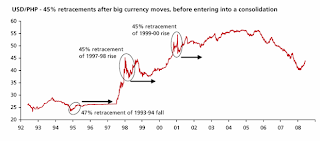``In a free economy the principal cause of a cumulative deficit in a country's international payments is to be found in inflation . . . In a country whose currency is not convertible into gold, inflation leads to its continuous devaluation in terms of foreign currencies.”- Michael A. Heilperin, International Monetary Economics
With the hazard from “food and fuel inflation” likely to diminish, there is a strong likelihood that the Peso could rally following its latest string of precipitate decline.

Figure 6: DBS Bank: Peso’s habitual 45-47% retracements
Of course, the BSP’s unexpected 50 basis points hike provoked a furious rally in the Philippine Peso up 2.45% over the week.
But nonetheless we would like to emphasize that a rallying Peso might not reflect equal strength into other the Philippine asset classes YET, unless foreign sentiment reverses.
I have seen similar patterns abroad with currency strongly firming up, such as some CEE (Central and Eastern Europe) nations or Norway, as central banks raise rates to positive levels but equity markets continue to falter.
Most of the weaknesses in these financial markets (including the Philippines) could be traced to decelerating global economic growth and the ongoing international credit crisis than from “inflation” (which has admittedly aggravated the circumstances than have caused it).
However, I maintain the view that perhaps we are in the 8th to the 9th inning of the cyclical decline or nearing the bottoming phase for the Phisix, barring any major shocks.
Stripping away the fundamental argument, DBS bank believes that the Peso has a habit of correcting 45%-47% before resuming on its major trend.
Quoting DBS Bank, ``Historically, USD/PHP is known to retrace about 45% of large moves, like it did in 1997/98 and 2000/01. Like these two episodes, the PHP is currently confronting an uncertain global economy. Assuming that the same 45% retracement takes place, USD/PHP could extend its rise to 47 before entering into a broad consolidation, possibly between 41 and 47. If export competitiveness becomes a priority with the government, the consolidation range could be narrow at 45-47 instead.”
With amplified recession risks coming from a global economic growth slowdown, Anglo Saxon economies are likely to commit more of their taxpayer’s money into patching up the gaping holes into their respective financial markets which extrapolates to more balance sheet expansions or fiscal degradations (a.k.a. inflationary activities). So aside from the probability of reduced “domestic” inflation, compounded by the prospects of further BSP actions, a strengthening Peso could be in the offing.
As for market timing or the practice of financial astrology, we are most of time too early.

No comments:
Post a Comment